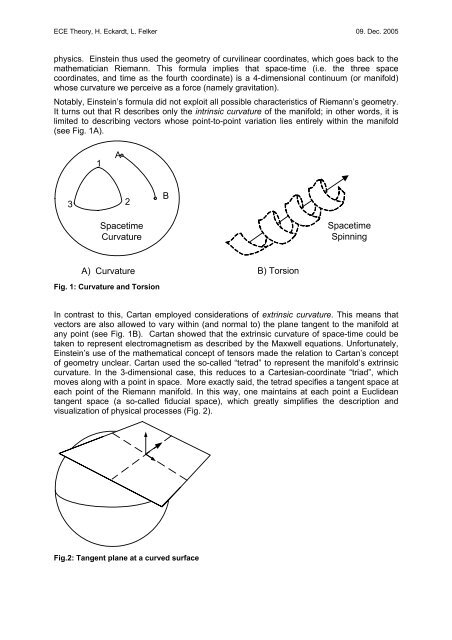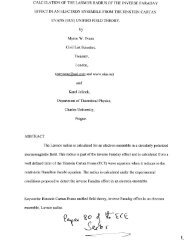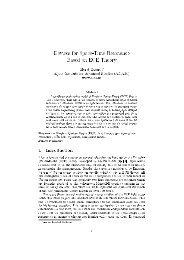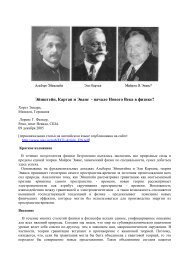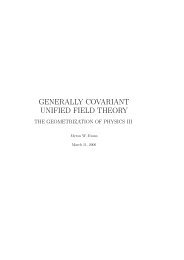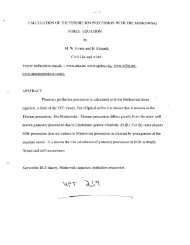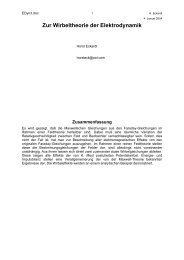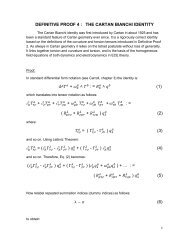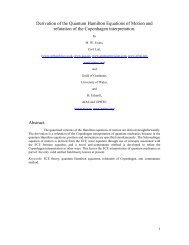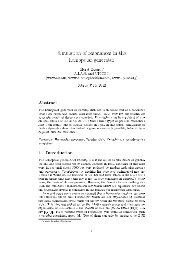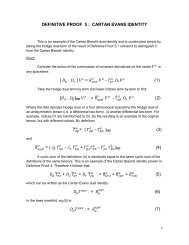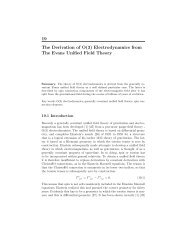Einstein, Cartan and Evans – Start of a New Age in Physics? - Aias.us
Einstein, Cartan and Evans – Start of a New Age in Physics? - Aias.us
Einstein, Cartan and Evans – Start of a New Age in Physics? - Aias.us
You also want an ePaper? Increase the reach of your titles
YUMPU automatically turns print PDFs into web optimized ePapers that Google loves.
ECE Theory, H. Eckardt, L. Felker 09. Dec. 2005<br />
physics. <strong>E<strong>in</strong>ste<strong>in</strong></strong> th<strong>us</strong> <strong>us</strong>ed the geometry <strong>of</strong> curvil<strong>in</strong>ear coord<strong>in</strong>ates, which goes back to the<br />
mathematician Riemann. This formula implies that space-time (i.e. the three space<br />
coord<strong>in</strong>ates, <strong>and</strong> time as the fourth coord<strong>in</strong>ate) is a 4-dimensional cont<strong>in</strong>uum (or manifold)<br />
whose curvature we perceive as a force (namely gravitation).<br />
Notably, <strong>E<strong>in</strong>ste<strong>in</strong></strong>’s formula did not exploit all possible characteristics <strong>of</strong> Riemann’s geometry.<br />
It turns out that R describes only the <strong>in</strong>tr<strong>in</strong>sic curvature <strong>of</strong> the manifold; <strong>in</strong> other words, it is<br />
limited to describ<strong>in</strong>g vectors whose po<strong>in</strong>t-to-po<strong>in</strong>t variation lies entirely with<strong>in</strong> the manifold<br />
(see Fig. 1A).<br />
1<br />
A<br />
3<br />
2<br />
B<br />
Spacetime<br />
Curvature<br />
Spacetime<br />
Sp<strong>in</strong>n<strong>in</strong>g<br />
A) Curvature<br />
B) Torsion<br />
Fig. 1: Curvature <strong>and</strong> Torsion<br />
In contrast to this, <strong>Cartan</strong> employed considerations <strong>of</strong> extr<strong>in</strong>sic curvature. This means that<br />
vectors are also allowed to vary with<strong>in</strong> (<strong>and</strong> normal to) the plane tangent to the manifold at<br />
any po<strong>in</strong>t (see Fig. 1B). <strong>Cartan</strong> showed that the extr<strong>in</strong>sic curvature <strong>of</strong> space-time could be<br />
taken to represent electromagnetism as described by the Maxwell equations. Unfortunately,<br />
<strong>E<strong>in</strong>ste<strong>in</strong></strong>’s <strong>us</strong>e <strong>of</strong> the mathematical concept <strong>of</strong> tensors made the relation to <strong>Cartan</strong>’s concept<br />
<strong>of</strong> geometry unclear. <strong>Cartan</strong> <strong>us</strong>ed the so-called “tetrad” to represent the manifold’s extr<strong>in</strong>sic<br />
curvature. In the 3-dimensional case, this reduces to a Cartesian-coord<strong>in</strong>ate “triad”, which<br />
moves along with a po<strong>in</strong>t <strong>in</strong> space. More exactly said, the tetrad specifies a tangent space at<br />
each po<strong>in</strong>t <strong>of</strong> the Riemann manifold. In this way, one ma<strong>in</strong>ta<strong>in</strong>s at each po<strong>in</strong>t a Euclidean<br />
tangent space (a so-called fiducial space), which greatly simplifies the description <strong>and</strong><br />
visualization <strong>of</strong> physical processes (Fig. 2).<br />
Fig.2: Tangent plane at a curved surface


